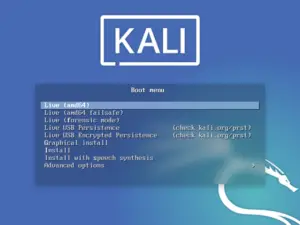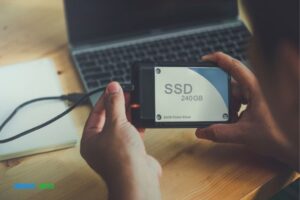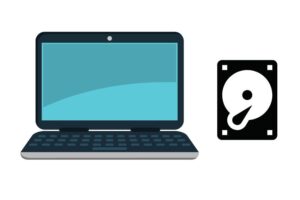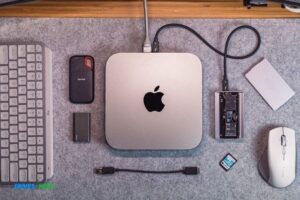Connect External SSD to Android Phone: 8 Steps!
In the era of expanding digital storage needs, the ability to connect external devices to our smartphones becomes increasingly valuable. This guide provides a concise walkthrough on how to effortlessly connect an external SSD to your Android phone.
Leveraging the USB On-The-Go (OTG) functionality, you can expand your phone’s storage capacity and conveniently transfer files between devices.
Whether you’re looking to offload photos, videos, or documents, this step-by-step guide ensures a seamless and efficient process, allowing you to make the most out of your Android phone’s capabilities.
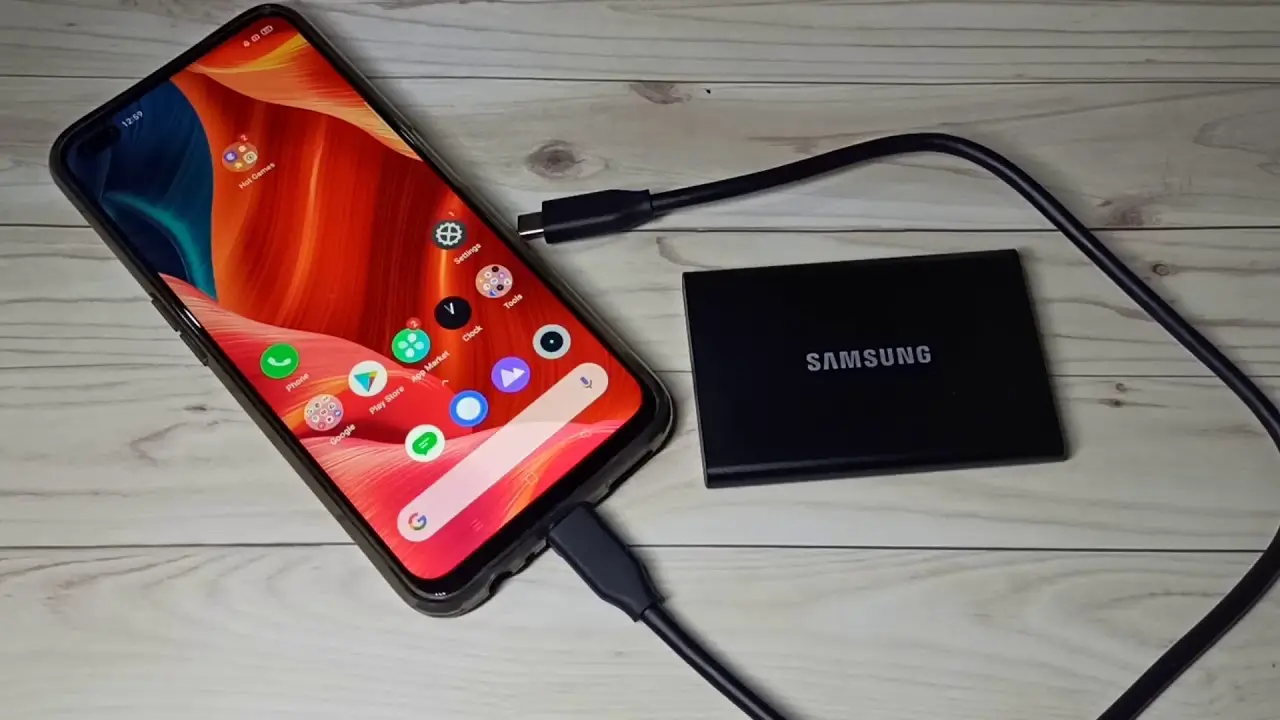
Key Takeaway
Connecting External SSD to Android Phone: Step-by-Step
Step 1: Check USB OTG Compatibility
- Ensure your Android phone supports USB On-The-Go (OTG) functionality. Most modern Android devices support this feature.
Step 2: Get a USB OTG Adapter
- Purchase a USB OTG adapter if your phone didn’t come with one. These adapters allow you to connect USB devices to your phone.
Step 3: Connect External SSD
- Plug one end of the USB OTG adapter into your phone’s charging port.
- Connect the external SSD to the other end of the adapter using a standard USB cable.
Step 4: Check File System Compatibility
- Ensure the external SSD is formatted with a file system compatible with Android, such as exFAT or FAT32. If not, you may need to reformat it using a computer.
Step 5: Access Files
- Once connected, your Android phone should recognize the external SSD.
- Use a file manager app on your phone to navigate to the external SSD and access its files.
Step 6: Transfer Files
- You can now transfer files between your Android phone and the external SSD.
- Select the files you want to transfer, then copy or move them to/from the external SSD as needed.
Step 7: Safely Eject
- After you’ve finished transferring files, safely eject the external SSD from your Android phone to avoid data corruption.
- Use the “Eject” or “Unmount” option in your file manager app to safely disconnect the SSD.
Step 8: Disconnect
- Unplug the USB OTG adapter from your phone’s charging port and remove the external SSD from the adapter.
By following these steps, you can easily connect and transfer files between an external SSD and your Android phone using a USB OTG adapter.
Five Facts About Connecting External SSD to Android Phone
Understanding Ssds For Android Phones
Android users can now expand the storage capacity of their phones by connecting external SSDs. Learn how to connect and utilize an SSD with your Android device for improved performance and increased storage space.
Introduction To Ssds And Their Benefits:
- SSDs are storage devices that use flash memory technology to store data.
- Unlike traditional hard disk drives (HDDs), SSDs have no moving parts, which makes them more durable and less prone to mechanical failures.
- SSDs provide faster read and write speeds, resulting in quicker app launches, file transfers, and overall responsive performance.
- With larger storage capacities available, you can store an extensive amount of media files, documents, and applications without worrying about running out of space.
Overview Of How Ssds Can Enhance Android Phone Storage:
- By connecting an external SSD to an Android phone, you can expand its storage capacity without relying solely on the internal storage.
- The additional space allows you to keep a vast library of music, videos, photos, and other media files, ensuring you have everything you need while on the go.
- The increased storage capacity also enables you to install more applications and games without facing restricted storage warnings.
Introduction To Connecting Ssds To Android Phones:
- To connect an SSD to your Android phone, you will need a compatible USB OTG (On-The-Go) adapter.
- The USB OTG adapter allows your Android phone to act as a host, enabling the connection of external devices such as SSDs.
- Once you have the USB OTG adapter, simply connect the SSD to your Android phone using a USB cable, and it will be recognized as an external storage device.
- Your Android phone will then provide access to the files and data stored on the SSD, allowing you to manage and transfer them easily.
SSDs offer a multitude of benefits when connected to Android phones. From increasing storage capacity to boosting performance, these small but mighty drives can greatly enhance your mobile experience.
With the right USB OTG adapter, connecting an external SSD to your Android phone is a straightforward process that opens up a world of possibilities for managing and expanding your device’s storage.
Setting Up An External SSD on An Android Phone
Setting up an external SSD on your Android phone is a seamless process that allows for increased storage capacity and faster data transfer.
With simple steps, you can connect your external SSD and enjoy the benefits of expanded storage on your device.
Exploring Software Options For Connecting And Accessing The Ssd
When it comes to connecting and accessing an external SSD on your Android phone, there are a few software options to consider. These options enable seamless connectivity and easy file management.
Here are a few notable ones:
- OTG File Explorer Apps: Downloading a file explorer app with OTG (On-The-Go) support is one of the simplest ways to connect and access your external SSD on an Android phone. These apps allow you to browse and manage files stored on both internal and external storage.
- USB On-The-Go (USB OTG) Support: Many Android devices come with built-in USB OTG support, which allows you to directly connect your external SSD using a USB OTG adapter. This method provides a direct and quick connection between your phone and the SSD.
- External Storage Managers: Some Android devices also offer their own proprietary external storage managers, like Samsung’s “My Files” app. These managers provide a user-friendly interface for connecting, managing, and transferring files to and from your external SSD.
Configuring The Android Device To Recognize And Use The Ssd
Connecting an external SSD to your Android phone is just the first step. To ensure your device recognizes and effectively uses the SSD, you may need to configure a few settings.
Here’s what you need to do:
- Connect the External SSD: Start by connecting your external SSD to your Android phone using a USB OTG adapter or a USB-C to USB-A cable, depending on the connection port of your device.
- Enable USB OTG Support: If your device doesn’t natively support USB OTG, you may need to enable it in your device settings. Simply navigate to the “Settings” menu, find the “Storage” or “Connected devices” section, and enable USB OTG support.
- Format the SSD (if necessary): In some cases, your Android device may prompt you to format the SSD before you can use it. Follow the on-screen instructions to format it and ensure compatibility with your phone.
Tips For Optimizing Ssd Performance On An Android Phone
Now that you have successfully connected and configured your external SSD, let’s explore some tips to optimize its performance on your Android phone:
- Organize Files: Keep your files organized on the SSD by creating folders and categorizing them based on type or usage. This will make it easier to find and access specific files when needed.
- Regularly Backup Files: Make it a habit to regularly back up your files from the SSD to another device or cloud storage. This will not only free up space on your SSD but also protect your data in case of device loss or failure.
- Update Android System: Ensure your Android device is running the latest software updates. These updates often include performance enhancements and bug fixes that can improve the compatibility and stability of external storage.
- Monitor Storage Space: Keep an eye on your SSD’s available storage space. Avoid filling it up to its maximum capacity, as this can slow down its performance. Maintain a reasonable amount of free space for optimal functionality.
Now that you have a good understanding of setting up an external SSD on an Android phone, you can enjoy the benefits of expanded storage capacity and easy file management. Start exploring the possibilities today!
Tips For Maintaining And Troubleshooting
From basic maintenance routines to troubleshooting common issues, this guide aims to empower you with the knowledge needed to keep your SSD connections hassle-free.
Tips For Maintaining And Troubleshooting Ssd Connections On Android Devices:
- Keep the SSD Firmware Updated: Regularly updating your SSD’s firmware ensures compatibility and may provide bug fixes that improve performance and stability when connected to your Android phone.
- Check Cable and Port Compatibility: Ensure that the cable you are using is compatible with both your SSD and Android phone. Additionally, regularly inspect the USB port on your Android device for any signs of damage or dirt that could hinder the connection.
- Disconnect Properly: Before unplugging your external SSD from your Android phone, always make sure to eject it safely to prevent data corruption. This ensures that files are saved and closed properly, protecting your data integrity.
- Restart and Reset: If you encounter any issues with your SSD connection, try restarting both your Android phone and the SSD. If the problem persists, you may need to reset your SSD settings or seek further assistance from the manufacturer’s support.
Final Thoughts On The Future Of Ssd Usage In The Android Ecosystem:
- The combination of external SSDs and Android phones has unlocked a new level of versatility and performance for mobile devices.
- As technology continues to advance, SSDs are becoming increasingly compact, capable, and affordable.
- With the rising demand for multimedia consumption, mobile gaming, and high-quality content creation on Android devices, SSDs are likely to play an even more significant role in the future.
- As the Android ecosystem evolves, we can expect to see further integration of SSD technology, offering users an unprecedented level of storage, speed, and convenience.
Connecting an external SSD to your Android phone not only enhances its storage capacity but also empowers you to effortlessly transfer files and enjoy seamless multimedia experiences.
By following the tips for maintaining and troubleshooting SSD connections, you can ensure a smooth and reliable experience.
As SSD technology continues to advance, the future holds immense potential for further integration and improved performance within the Android ecosystem.
FAQ On Connect External Ssd To Android Phone
How do I connect an external SSD to my Android phone?
You can use an external drive with an OTG (On-The-Go) cable to connect external drives such as a solid state drive (SSD) to your Android device. Most modern Android devices support this.
Are there any compatibility issues when connecting an external SSD to my Android phone?
Yes, some external SSDs may not be compatible with some Android devices. It is recommended to check with the manufacturer for compatibility.
Does connecting an external SSD to my Android phone slow down the device?
No, an external SSD should not slow down your device as it is an external storage source and not part of the internal hardware of your device.
Do I need any special software or tools to connect an external SSD to my Android phone?
Generally no, it should just work when plugged in using an OTG (On-The-Go) cable. However, some apps may be required for certain features such as sharing or file format support.
Can I use an external SSD as internal storage for my Android device?
Yes, some Android devices may allow for the external SSD to be used as internal storage. However, this will vary depending on device and may require special software or tools.
Conclusion
Connecting an external SSD to an Android phone is a game-changer for those seeking to expand their device’s storage and enhance its performance.
With its high-speed data transfer capabilities and ample storage capacity, an external SSD offers a seamless solution for managing large files, running demanding applications, and ensuring a smooth multimedia experience.
By following the simple steps outlined in this guide, anyone can effortlessly connect their SSD to their Android phone and enjoy the benefits it brings.
Whether you need additional space for photos, videos, or apps, or you want faster access to your data on the go, integrating an external SSD with your Android phone opens up a world of possibilities.

